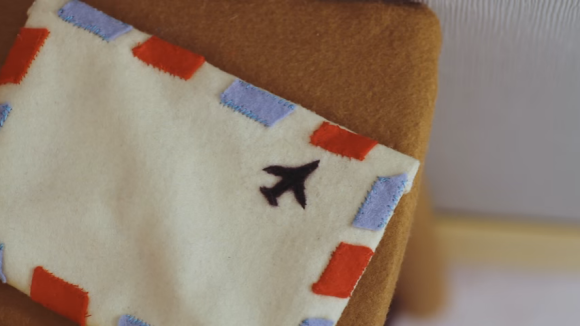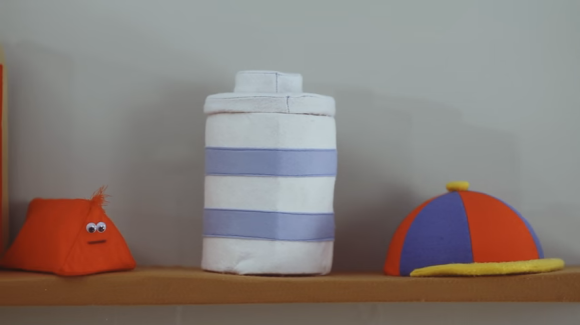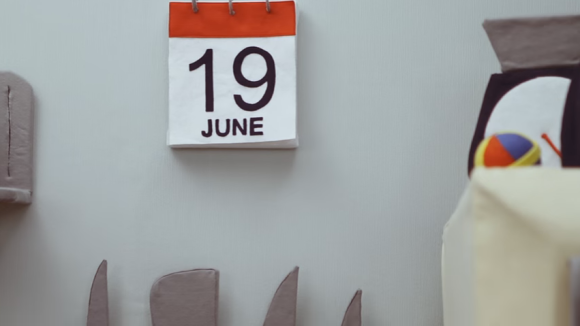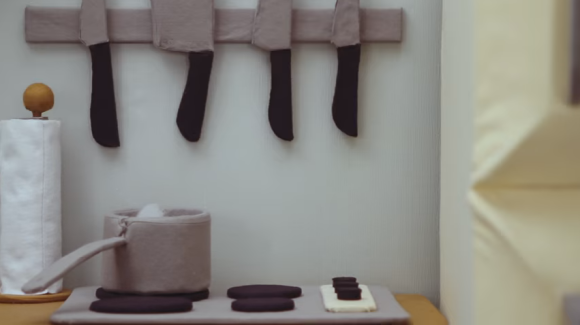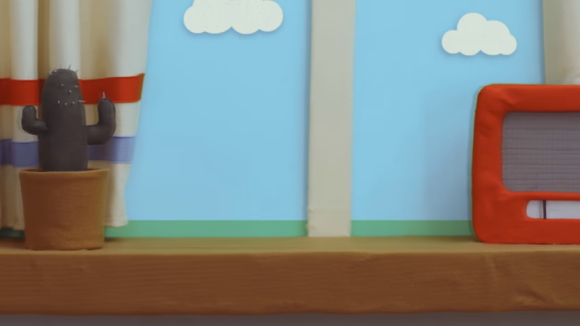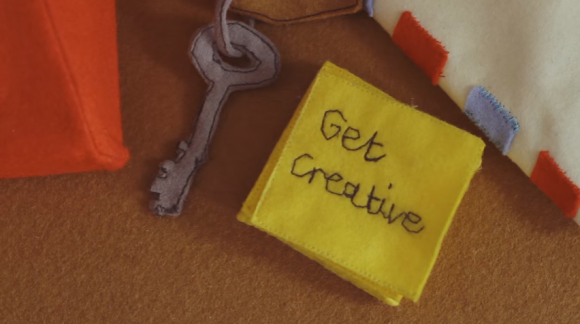(Note: since I have reason to suspect that the final episode will be coming out tomorrow, and since I’d like to at least address all of the episodes, these will be more like bullet points than full essays. Management reserves the right to rewrite or expand them later, even though they’re probably wrong.)
What’s your favorite idea?
Mine is being creative.
And so the lessons begin. Through music and visuals, the Sketchbook attempts to teach The Red Guy, The Yellow Guy, and The Green Duck Guy about creativity.
Red and Yellow show a dramatic and excited reaction, leaning toward the Sketchbook. Yellow’s mouth is agape, and he looks wholly amazed. But Green does not even move. He is completely unsurprised – either because similar things have happened before, or because the very same thing has happened before. As stated in the previous essay, the characters behave as actors waiting for their cues. Perhaps Duck Guy is weary of this role, after many takes.
This question and its response come on like a koan. The notion of having a “favorite idea” is bizarre. Treating “being creative” as an idea unto itself is stranger still. Creativity is not being treated as a process or method, but as an entity in its own right.
How do you get the idea?
I just try to think creatively.
Creativity is treated as both cause and effect here: Sketchbook got the idea for being creative by thinking creatively. This doesn’t impart knowledge to the unfamiliar. You need to accept the wisdom of the answer and be capable of applying it already in order to gain and apply the wisdom in the first place.
The rhyme scheme is also simplistic. “Idea” is rhymed with “idea.” “Creative” is rhymed with “creatively.” Tautologies are the antithesis of creativity.
Now, when you look at this orange,
Tell me, please, what do you see?
It’s just a boring old orange!
Maybe to you, but not to me.
A bold move, ending a line with “orange,” one of the English language’s most famously-rhymeless words. Almost any other fruit could have worked – like “apple,” or even “pear.”
Why, then, an orange? Given the nature of the puppets as puppets, the attempts at inculcation, and the hints of authoritarianism, it evokes A Clockwork Orange.
Strangely enough, when you stare into this fruit basket, the fruit basket stares into you.
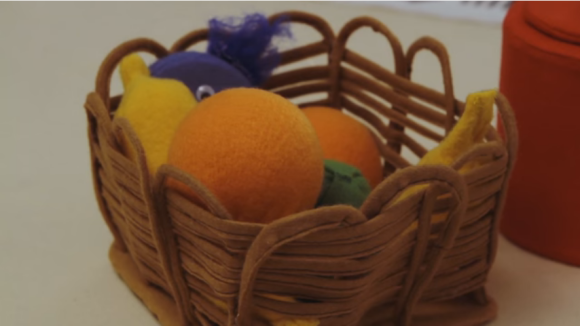
Something blue is at the back of the basket. It has a googly eye and either a feather or a tuft of hair. This seems to be yet another entity that has a face, yet is not treated as a character.
The orange is, however.
I see a silly face (Wow!)
Walking around and smiling at me
I don’t see what you mean!
‘Cause you’re not thinking creatively!
The Yellow Guy, who comes across as somewhat naive, childlike, and unintelligent, is at least playing along, expressing enthusiasm at the Sketchbook’s creativity.
Red is somewhat more ambivalent, and his character comes across as apathetic. He reacted to the Sketchbook’s appearance, but not as dramatically.
Green is more pragmatic and more fussy. He’s trying to learn, in that he’s questioning the Sketchbook and attempting to get her to explain herself in a way that might make more sense to him. However, his failure to learn this way of thinking is being treated as the reason he failed to learn this way of thinking in the first place. His inability to see the world the same way as someone else is being called “uncreative,” and he’s being told he should change how he thinks. This is conformity dressed as creativity.
The attempted rhyme scheme reverses here. The first two lines of each couplet don’t even come near a rhyme, but me / creatively succeeds.
So take a look at my hair (Cool!)
I use my hair to express myself.
That sounds really boring.
I use my hair to express myself.
While Green is trying to engage with the Sketchbook and to demand , Red seems to be more random. He played along in the beginning, mugging a reaction, and his voice can be heard saying “Cool,” though Green’s cannot. However, Red also resists the Sketchbook, saying her attempt at expression is boring.
When confronted with the idea that her attempts at wild and colorful self-expression are, in fact, boring, the Sketchbook’s only response is to repeat her assertion that she’s expressing herself. It as if she cannot conceive how her personal self-expression could be seen as boring to anybody else, and therefore Red must not have heard her the first time, or must not have understood her – his response couldn’t possibly be his own genuine self-expression.
There could also be some mockery of those who’d wear “wild” hairstyles to express themselves in the first place – given that hair grows out and can be dyed, making it a safe and risk-free way to creatively express oneself. Perhaps the argument is that real creative self-expression entails more risk – and doesn’t need to be explained or asserted.
Perhaps Red is saying that her hair is cool, and it would be cooler if it was there for its own sake: her insistence that it’s “expressive” gives it meaning and purpose, and therefore makes it dull. Ars gratia artis, after all.
She never risks letting others draw on her, or drawing on herself – she doesn’t seem to express herself by her own hand, or to facilitate creativity in anyone else. Rather, she just acts as a presentation, flipping from already-existing illustration to illustration.
Now, when you stare at the clouds in the sky,
Don’t you find it exciting?
No.
It’s not looking at clouds that’s engaging – it’s the search for patterns. (Even then, it’s not “exciting,” it’s generally more relaxing.) Still, is pareidolia a creative act? It doesn’t analyze or recreate or compare – it just involves looking at an amorphous or ambiguous shape and recognizing the shape of something familiar. Being able to see more things might denote higher creativity or adaptability. So might an ability to see things in both the positive and the negative space. But I would argue that there’s nothing creative about seeing a shape in a cloud or a face in a rock formation on Mars. The mind simply recognizes a pattern in things as they are, comparing them to other things-as-they are, whereas creativity involves an ability to imagine things as being other than they are.
Come on, take another look! (Oh wait!)
I can see a hat, I can see a cat,
I can see a man with a baseball bat.
I can see a dog, I can see a frog,
I can see a ladder leaning on a log!
Curiously, “creativity” appears to involve each person seeing the same thing at the same time. Genuine creativity would arguably result in a wider diversity of perceptions. Still, the Sketchbook asserts that they’re on the right track.
Think you’re getting the hang of it now!
Using your minds to have a good time.
I might paint a picture of a clown!
Whoa there, friend; you might need to slow down.
The Duck Guy still looks dubious and unimpressed, even as the Skechbook says they’re doing well.
The direct connection between the mind and time is somewhat odd. In the phrase “have a good time,” time is being used in a much more abstract sense. But the picture illustrates both very literally – the mind is a brain, and time is a clock. This is a very reductionist approach for someone who supposedly advocates creativity.
It also foreshadows the second episode, which focuses on time – and which begins to address the idea of time as a human invention, not an actual entity.
And so is pausing the entire song to dump black paint all over Yellow’s painting of a clown.
Why should he slow down? Even if he’s comprehending creativity (or the Sketchbook’s concept of it) more quickly than The Duck Guy, there’s no sense in destroying his progress or holding him back – unless, of course, even the Sketchbook realizes that she’s not advocating real creativity, and is just encouraging a sort of versatile positivity within arbitrary authoritarian constraints.
What sort of creative exercise does the Sketchbook support instead?
Here’s another good tip (Yeah?)
Of how to be a creative whiz kid:
Go and collect some leaves and sticks
And arrange them into your favorite color.
Again, this is koan-like insensibility. It does make much more sense to have a favorite color than a favorite idea – but arranging “leaves and sticks” into a color can’t exactly be done.
And so they arrange the leaves and sticks into the words for colors – the signifiers instead of the signified.
Blue!
Red!
Green!
Green is not a creative color.
The Red Guy picks the color blue. The Green Guy picks the color red. Yellow picks Green, and is scolded, his work covered with a large black X.
Yellow was not asked to arrange them into a creative color, just into his favorite color. He’s punished for taking the Sketchbook at her word instead of paying attention to the subtext – that his favorites should now be in line with her ideals.
No reason is given for why green is not a creative color. Perhaps it’s because leaves and sticks are already greenery, so using greenery to spell “green” requires too little imagination or seeing-things-as-they-aren’t.
However, again, the Sketchbook thinks creativity is nothing but seeing whatever everybody else sees. Whatever complaint she has about green, the fact that it’s not truly creative enough is unlikely to be one of them.
Perhaps there is something else that is wrong or threatening about the color green.
Blue and red, both primary colors, were fine – but green is a secondary color, made by combining yellow and blue. It is, itself, created, a sum of disparate parts, and it is therefore an objectively creative color. It looks all the more as if the Sketchbook is only interested in asserting authority – legitimate displays of creativity are blacked out, X’d out, or otherwise maligned.
There’s one more thing that you need to know
Before you let your creativity flow:
Listen to your heart, listen to the rain,
Listen to the voices in your brain.
This would be three more things. The depiction of a heart shows a more anatomically-correct heart, aorta and all – another very literal depiction.
“Listen to the rain” seems more abstract, but it’s not an encouragement to listen for patterns, melodies, voices, or anything else in the rain besides the literal sound of raindrops hitting surfaces.
On “Listen to the voices in your brain,” the Sketchbook shows a simplified image of the lobes of the human brain.
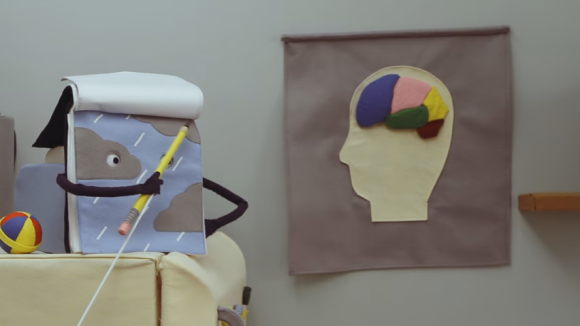
An image of grey matter would have sufficed, but the lobes have been created – and color-coded.
The forebrain is blue – Red’s favorite color. This is the part of brain that controls decision making, reasoning, planning, problem solving, and ethical choices. It may be worth noting that damage to the frontal lobe can result in a lack of emotional affect – a failure for emotional states to be reflected in facial expression or tone of voice. This evokes Red’s muted, neutral reactions.
But the lobe in green is the temporal lobe. It’s the lobe that processes sensory input, recognizes language, and forms long-term memories. If green is a forbidden color, and the temporal lobe is green, then the Sketchbook is cautioning against accurately processing the evidence of the senses, against comprehending language, and against remembering events of the past – all of which could be used to refute or disbelieve authority.
Come on, guys, let’s get creative!
The fridge shows “Get Creative” in colorful fridge magnets – and then the image snaps from live live action to rather-dated CGI, as might be seen in an extremely low-budget children’s cartoon. The letters fly off the fridge and toward the camera.
A montage of live-action creativity begins – the characters using traditional childrens’ craft materials like glitter and googly eyes, popsicle sticks and potato stamps to create random-seeming amalgams of matter.
The camera returns to the live-action shot of the three characters sitting at the table. The image flickers between this and a crude CGI representation of the characters and the kitchen.
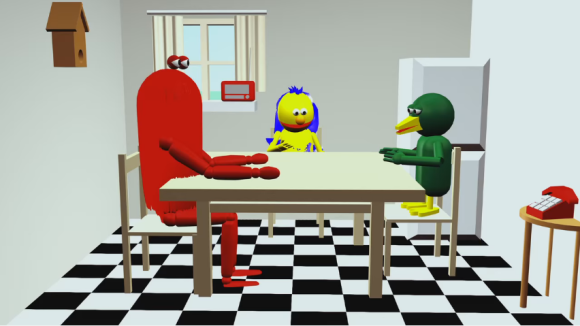
The camera pans around the table, and the kitchen falls apart – the walls slip aside, and the cuckoo clock swirls through the air. Soon we see what has been behind the “fourth wall.” The characters are being filmed, and are aware of this: there are cameras, a boom mic, a clapboard, and a director’s chair – all manned by creatures that appear to be nothing but giant eyeballs on yellow birdlike legs. The background is the pale blue-green with confetti, as in the title card.
But as the scenery is changing and previously-unrevealed entities are being shown, the characters are changing as well. When the camera returns to its initial position, Yellow and Green are significantly different:
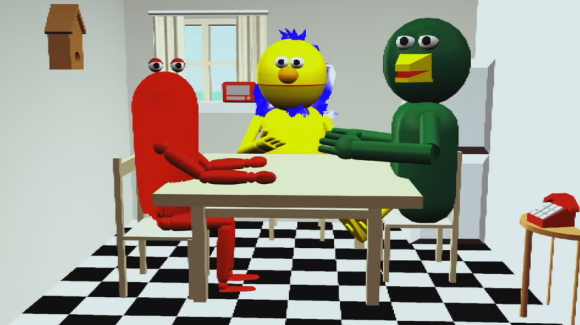
Both are taller and broader. They appear to be adults. This could be seen to represent the same characters, only older – or it could represent their parents.
The image becomes pixelated, then returns to a live-action view. The puppets are no longer the same, and no longer appear to be puppets at all, but rather people in full costume.
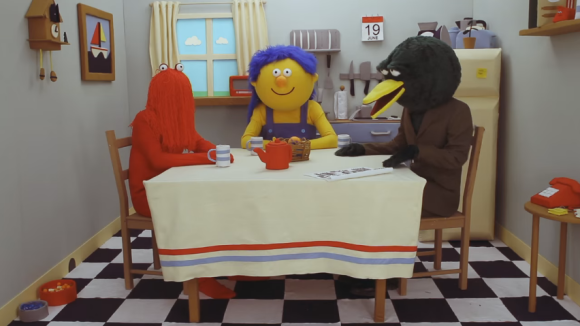
Another craft montage begins. A raw human heart sits on a yellow background. Shredded confetti is haphazardly stuck to an ill-painted round disc. Red – or the elder Red – covers the heart in gold glitter.
The three stand in the kitchen again. The table is gone, and the letters of “Get Creative,” presumably having flown off of the fridge, now hover in the background. The calendar still shows June 19th. Yellow dances erratically while Red and Green look on.
The view looks out the window, where dark storm clouds roll in and a thunderstorm begins.
The music grows more and more frenzied – violins sawing, occasional discordant notes played over them.
All three characters now dance wildly. Red rolls the heart from the glitter, exposing the unglamoured flesh. He shakes and gyrates, rolling the heart in the glitter, blood smearing the pale yellow surface.
The original puppet Yellow is seen again, convulsing somewhat, while the Sketchbook looks on in apparent approval.
The three larger, adult characters sit at the table again, excitedly cutting into a cake bearing pale blue frosting and the words “Get Creative.” Red and Yellow clap as Green removes a slice. The cake is full of offal.
Red and Yellow, two of the three primary colors, are represented in these characters. So is Green. Perhaps Blue is in the cake.
The three hug and spin as the music reaches a peak of screeching frenzy. Green’s potato stamps spell “DEATH” and the H trails off into a smear as his limp hand slides down the frame. Fallen offal is pulled into the mousehole by an unseen agent. The small version of Yellow convulses again, even more wildly, and the Elder Green scoops more offal into the cake. The DEATH potato stamps are seen surrounded by skull stamps and smears and by the potatoes themselves, and Green’s hand casts them away as cymbals crash and faint screams echo.
Through this cacophonous phantasmagoria, creativity is shown to be far from the tame and rulebound ideal expressed before. It is unhinged, it follows no pattern, it is heedless of time. It confronts mortality. The raw matter of the world, of plants, of animals, even the very hearts of animals and the innards that work within them, is distorted and changed. Potatoes are used as stamps, hearts are covered with glitter, organs are made into cakes. Food, life, art, and death are all intertwined. It is unclear what the dancing is meant to celebrate – life and art, or death itself.
Perhaps this is a view of the past – of the characters’ parents, on June 19th of 1955, another Father’s Day, performing some sort of creative / destructive rite, a summoning or appeasement of horror, which the main characters now have to live with.
The screams die away, and we see the Sketchbook and Green again, Green in his original form. The original view is shown once more – Red looking at the Sketchbook, Yellow looking distraught, but not making eye contact with the camera, the Green Duck Guy looking vaguely toward the book. Nothing has changed in the kitchen. Time does not seem to have passed, to go by the clock.
Yellow looks around, as if confused, though the other characters show minimal reaction to the events. The upbeat music strikes up again.
Now let’s all agree to never be creative again.
With a discordant honk of a woodwind, the Sketchbook falls backward, its cover closing over it once more, and the screen goes black.
Next Entry: Frenzied Nigh-Random Bullet-Point Observations About Other Things In The Rest Of The Series.

